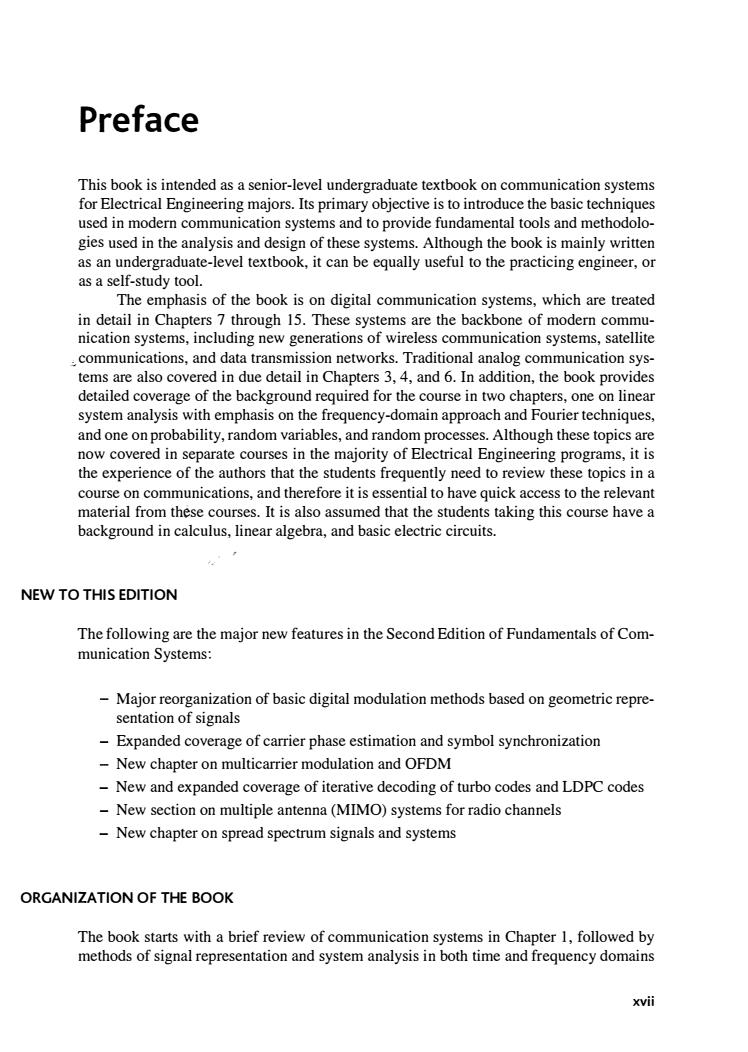正在加载图片...

Preface This book is intended as a senior-level undergraduate textbook on communication systems for Electrical Engineering majors.Its primary objective is to introduce the basic techniques used in modern communication systems and to provide fundamental tools and methodolo- gies used in the analysis and design of these systems.Although the book is mainly written as an undergraduate-level textbook,it can be equally useful to the practicing engineer,or as a self-study tool. The emphasis of the book is on digital communication systems,which are treated in detail in Chapters 7 through 15.These systems are the backbone of modern commu- nication systems,including new generations of wireless communication systems,satellite communications,and data transmission networks.Traditional analog communication sys- tems are also covered in due detail in Chapters 3,4,and 6.In addition,the book provides detailed coverage of the background required for the course in two chapters,one on linear system analysis with emphasis on the frequency-domain approach and Fourier techniques, and one on probability,random variables,and random processes.Although these topics are now covered in separate courses in the majority of Electrical Engineering programs,it is the experience of the authors that the students frequently need to review these topics in a course on communications,and therefore it is essential to have quick access to the relevant material from these courses.It is also assumed that the students taking this course have a background in calculus,linear algebra,and basic electric circuits. NEW TO THIS EDITION The following are the major new features in the Second Edition of Fundamentals of Com- munication Systems: Major reorganization of basic digital modulation methods based on geometric repre- sentation of signals Expanded coverage of carrier phase estimation and symbol synchronization -New chapter on multicarrier modulation and OFDM -New and expanded coverage of iterative decoding of turbo codes and LDPC codes -New section on multiple antenna (MIMO)systems for radio channels New chapter on spread spectrum signals and systems ORGANIZATION OF THE BOOK The book starts with a brief review of communication systems in Chapter 1,followed by methods of signal representation and system analysis in both time and frequency domains xviiPreface This book is intended as a senior-level undergraduate textbook on communication systems for Electrical Engineering majors. Its primary objective is to introduce the basic techniques used in modern communication systems and to provide fundamental tools and methodologies used in the analysis and design of these systems. Although the book is mainly written as an undergraduate-level textbook, it can be equally useful to the practicing engineer, or as a self-study tool. The emphasis of the book is on digital communication systems, which are treated in detail in Chapters 7 through 15. These systems are the backbone of modern communication systems, including new generations of wireless communication systems, satellite , communications, and data transmission networks. Traditional analog communication systems are also covered in due detail in Chapters 3, 4, and 6. In addition, the book provides detailed coverage of the background required for the course in two chapters, one on linear system analysis with emphasis on the frequency-domain approach and Fourier techniques, and one on probability, random variables, and random processes. Although these topics are now covered in separate courses in the majority of Electrical Engineering programs, it is the experience of the authors that the students frequently need to review these topics in a course on communications, and therefore it is essential to have quick access to the relevant material from these courses. It is also assumed that the students taking this course have a background in calculus, linear algebra, and basic electric circuits. NEW TO THIS EDITION The following are the major new features in the Second Edition of Fundamentals of Communication Systems: Major reorganization of basic digital modulation methods based on geometric representation of signals - Expanded coverage of carrier phase estimation and symbol synchronization New chapter on multicarrier modulation and OFDM - New and expanded coverage of iterative decoding of turbo codes and LDPC codes - New section on multiple antenna (MIMO) systems for radio channels - New chapter on spread spectrum signals and systems ORGANIZATION OF THE BOOK The book starts with a brief review of communication systems in Chapter 1, followed by methods of signal representation and system analysis in both time and frequency domains xvii